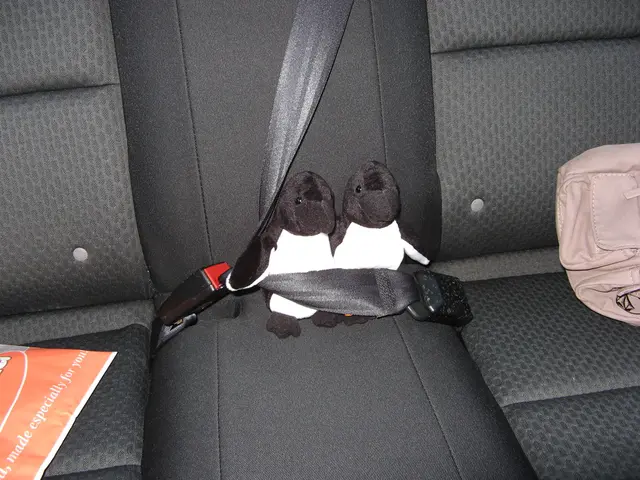Intuitive Leadership: Mastering the Skill of Making Critical Decisions
Rewritten Article:
Aslak de Silva, helming Selfly Store as CEO, is driving growth and revenue across 20+ countries using data and smart vending machines, all while making crucial decisions on the fly.
In today's data-driven world, leaders are often stuck, searching for that elusive, perfect piece of information before making a decisive move. However, in the face of uncertainty, sitting on our hands can cost us valuable opportunities. Instead, I've found that embracing a daring demeanor and trusting our instincts often leads us down the right path, even when the stakes are sky-high.
Data: Your Two-Faced Buddy
Data is nothing short of a treasure trove—it informs our strategies, squashes doubt, and unearths patterns. But as famed psychologist Daniel Kahneman proposes in his book, "Thinking, Fast and Slow," decision-making frequently involves two systems: the swift, instinctual System 1 and the laborious, methodical System 2. While data appeals to System 2, our gutsy System 1 can guide us when we're feeling lost in the fog. Overdependence on data may result in paralysis, as leaders wrestle with the future's inherent uncertainties.
Kahneman's research underscores that intuition, honed by years in a relevant field, can be a formidable force—particularly in environments that offer consistent feedback loops. Yet, he warns against relying on intuition when biases or insufficient expertise might sway judgment.
In my practice, intuition shines brightest when I've found myself in similar waters before, while I rely on data to explore the unknown terrain. The trick is knowing when our gut feeling is trustworthy and when a more systematic approach is necessary.
The Perils of Decision Overload
Roy Baumeister's exploration of decision fatigue sheds light on how our daily decision barrage can zap our mental energy, leading us to make poorer choices as the day drags on. For example, choosing your outfit the night before can conserve energy for the big decisions to come in the morning. Similarly, people tend to opt for less nutritious meals during suppertime because their decision-making energy has dwindled throughout the day.
For leaders, this means that it's not only important to act, but to prioritize and streamline decisions wherever possible. When Covid-19 struck, I carved out a training schedule from 3 p.m. to 5 p.m. and planned out my learning tasks. This way, I spared my mental energy for more critical leadership choices—ones that steered the course of my company or my career.
My experience reaffirmed the value of preparing for impending decisions, conserving my mental power for high-stakes choices that required deep focus. Instead of getting hung up on minor operational details, I kept my sights set on strategic decisions to maximize impact. By pinpointing the choices that truly mattered, I reserved my mental energy for choices that demanded my undivided attention.
Choices Within Choices: The Easy and Hard Decisions
Decisions can be broadly classified into two types: easy and hard. Easy choices are a breeze—one option has the upper hand when considering factors like cost, quality, or fit. For instance, when choosing a vendor for office supplies, one company offered speedy delivery, competitive pricing, and exceptional customer service. Settling on that supplier was a no-brainer, freeing up time and mental space to tackle more pressing matters. Easy choices require little mental exertion.
Hard decisions, however, require a robust examination of the available data and options, as there's no clear-cut winner. Whether it's steering a company towards a new direction, beefing up the team, or making a significant lifestyle shift, these decisions are laden with uncertainty. Sometimes, it's impossible to get a crystal-clear view of the future, but that's where faith comes in. Leap into the unknown, learn from the outcomes, and refine your strategy for the sequel.
Striking a Balance: When to Check and When to Checkmate
A bias for action is invaluable, yet it's equally essential to gauge the level of risk at stake. For high-stakes decisions, it's crucial to take a measured approach, mulling over scenarios and possible repercussions. However, when minor risks are on the line, letting analysis paralyze progress may pose more harm than good. The key is to weigh the potential downsides and decide if the risk is worth the reward.
Closing Thoughts
Leaders who cling to perfection in search of crystal-clear clarity might miss their taking-off cue. Effective decision-making isn't about wiping away uncertainty but about dancing with it with confidence. Trust your hunch, take action, and learn as you go—leading with a dash of audacity and agility in an ever-changing world.
In essence, the Forbes Business Council is the premier community for business owners and leaders eager to grow and network. Are you among them?
Aslak de Silva, an analytical leader at the helm of Selfly Store as CEO, has demonstrated that embracing a daring demeanor, trusting intuition, and relying on data can lead to growth and success across multiple countries. However, overdependence on data might result in paralysis when dealing with the uncertainties of the future. Balancing intuition and data-driven strategies is crucial, as leaders must be aware of their biases and insufficient expertise to avoid making mistakes. In environments offering consistent feedback loops, intuition can be a formidable force, but relying on it blindly can be risky. Thus, leaders should know when to trust their gut and when a more systematic approach is necessary.





